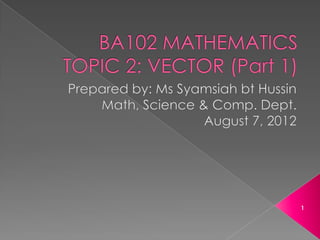BASIC VECTOR NOTES
•Télécharger en tant que PPTX, PDF•
1 j'aime•641 vues
Introduction to vector, for Malaysian Polytechnic's students. Especially for IT courses
Signaler
Partager
Signaler
Partager

Recommandé
Contenu connexe
Tendances
Tendances (19)
Banked turn and its effects on Stall speed of an Airplane

Banked turn and its effects on Stall speed of an Airplane
Physics F3 (IGCSE) speed, velocity and acceleration 

Physics F3 (IGCSE) speed, velocity and acceleration
En vedette
En vedette (18)
3 newton law of motion-Laws of Newtonian mechanics 

3 newton law of motion-Laws of Newtonian mechanics
Similaire à BASIC VECTOR NOTES
Similaire à BASIC VECTOR NOTES (20)
Relative velocity method, velocity & acceleration analysis of mechanism

Relative velocity method, velocity & acceleration analysis of mechanism
Dernier
Dernier (20)
Basic Civil Engineering first year Notes- Chapter 4 Building.pptx

Basic Civil Engineering first year Notes- Chapter 4 Building.pptx
Energy Resources. ( B. Pharmacy, 1st Year, Sem-II) Natural Resources

Energy Resources. ( B. Pharmacy, 1st Year, Sem-II) Natural Resources
Beyond the EU: DORA and NIS 2 Directive's Global Impact

Beyond the EU: DORA and NIS 2 Directive's Global Impact
Measures of Central Tendency: Mean, Median and Mode

Measures of Central Tendency: Mean, Median and Mode
This PowerPoint helps students to consider the concept of infinity.

This PowerPoint helps students to consider the concept of infinity.
Russian Escort Service in Delhi 11k Hotel Foreigner Russian Call Girls in Delhi

Russian Escort Service in Delhi 11k Hotel Foreigner Russian Call Girls in Delhi
Presentation by Andreas Schleicher Tackling the School Absenteeism Crisis 30 ...

Presentation by Andreas Schleicher Tackling the School Absenteeism Crisis 30 ...
Unit-V; Pricing (Pharma Marketing Management).pptx

Unit-V; Pricing (Pharma Marketing Management).pptx
BASIC VECTOR NOTES
- 1. 1
- 2. 2 Understand vector quantities • State the two components of a vector. • Draw a directed line to represent a vector.
- 3. Quantities such as time, temperature and mass are entirely defined by a numerical value and are called scalars or scalar quantities. › E.g. temperature in a room is 16 C. Quantities such as velocity, force and acceleration, which have both a magnitude and a direction, are called vectors. › E.g. the velocity of a car is 90km/h due west. 3
- 4. 4
- 5. A vector quantity can be represented graphically by a line, drawn so that: › the length of the line denotes the magnitude of the quantity, and › the direction of the line denotes the direction in which the vector quantity acts. An arrow is used to denote the sense, or direction, of the vector. The arrow end of a vector is called the ‘nose’ and the other end the ‘tail’. 5
- 6. For example, a force of 9N acting at 45◦ to the horizontal is shown in Fig. 1. Note that an angle of +45◦ is drawn from the horizontal and moves anticlockwise. Fig. 1 6
- 7. A velocity of 20m/s at −60◦ is shown in Fig. 2. Note that an angle of −60◦ is drawn from the horizontal and moves clockwise. Fig. 2 7
- 8. 8
- 9. 9 Solve addition vectors: • Determine the resultant vector using graphical method: i) triangle method, ii) parallelogram method.
- 10. Adding two or more vectors by drawing assumes that a ruler, pencil and protractor are available. Results obtained by drawing are naturally not as accurate as those obtained by calculation. 10
- 11. Triangle @ Nose-to-tail method › Two force vectors, F1 and F2, are shown in Fig. 3. › When an object is subjected to more than one force, the resultant of the forces is found by the addition of vectors. Fig. 3 11
- 12. To add forces F1 and F2: › Force F1 is drawn to scale horizontally, shown as Oa in Fig. 4. › From the nose of F1, force F2 is drawn at angle θ to the horizontal, shown as ab. › The resultant force is given by length Ob, which may be measured. This procedure is called the ‘nose-to-tail’ or ‘triangle’ method. 12
- 14. Parallelogram method › To add the two force vectors, F1 and F2, of Fig. 3: › A line cb is constructed which is parallel to and equal in length to Oa (see Fig. 5). › A line ab is constructed which is parallel to and equal in length to Oc. › The resultant force is given by the diagonal of the parallelogram, i.e. length Ob. This procedure is called the ‘parallelogram’ method. 14
- 16. A force of 5N is inclined at an angle of 45◦ to a second force of 8 N, both forces acting at a point. Find the magnitude of the resultant of these two forces and the direction of the resultant with respect to the 8N force by: › (a) the ‘nose-to-tail’method, and › (b) the ‘parallelogram’ method. Answer: 12N at (approximately) 17˚ from horizontal 16
- 19. 19
- 20. Prepare for Quiz 1 and Peer Assessment 1, for next class! 20
